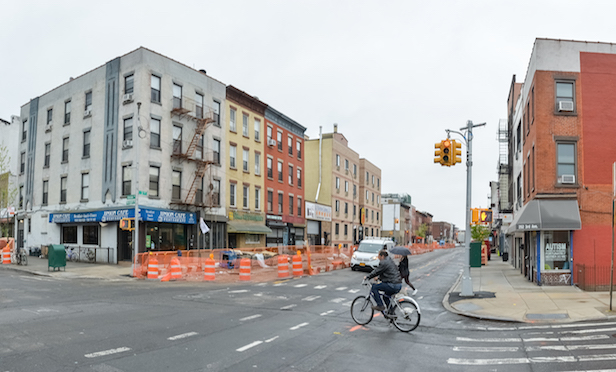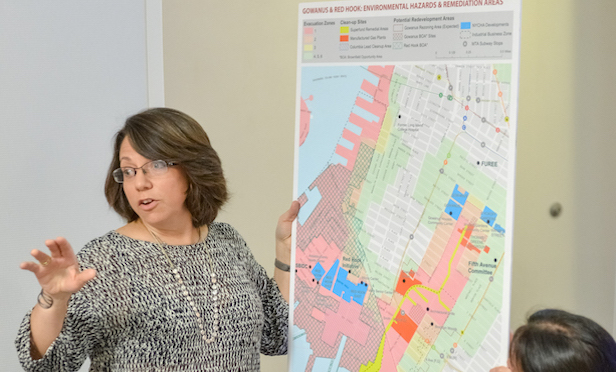
NEW YORK CITY—The anticipated rezoning of Gowanus, Brooklyn in furtherance of Mayor Bill de Blasio's housing plans, Housing New York: A Five-Borough, Ten-Year Plan and Housing New York 2.0, will increase development opportunities in the upcoming years.
The Urban Land Institute New York and the Fifth Avenue Committee, a South Brooklyn community non-profit group, organized a technical assistance panel (TAP) of environmental, real estate and transportation experts to study the Gowanus neighborhood. ULI then issued a report, recommending quality-of-life strategies, contemplating increased densification of buildings.
The report focuses on the Urban Heat Islands phenomenon, which occurs when buildings, asphalt and concrete replace plant life; and cars and air conditioners release additional heat into the environment. This heats up urban areas. The US EPA says in a city of a million people, this can increase the temperature 1.8 to 5.4 degrees hotter than its surroundings neighborhoods.
Urban heat islands can prevent cities from cooling off at night, getting up to 22 degrees hotter than neighboring areas. The CDC reports that each summer more than 65,000 people visit the ER for heat illnesses, and that between 2006 and 2015, heat caused the deaths of 1,130 people.
ULI states 4,000 public housing tenants live in Gowanus. It notes they tend to be lower-income, older, and having higher rates of asthma and other chronic diseases compared with the general population. The US Census Bureau reports 25% to 50% of Gowanus residents live below the poverty level.
Urban heat islands particularly affect the poor and underserved populations, as most do not have air conditioning and are vulnerable to heat-related health problems.
In addition, the report points out that extreme heat increases energy demands, air conditioning use, air pollution, greenhouse gas emissions and water pollution.

“Offsetting the impacts of this UHI phenomenon should be a high priority during any redevelopment plan for Gowanus,” says TAP chairman, James Lima, president of James Lima Planning + Development. “Gowanus faces a series of complex challenges ranging from UHI effect to Superfund site toxicity, and poor air quality, among other public health concerns. The anticipated rezoning process presents a timely opportunity to coordinate and implement numerous important measures that can help ensure the health and vitality of Gowanus residents for years to come.”

ULI NY Chairman Marty Burger, CEO, Silverstein Properties, commends the ULI NY TAP process for bringing together land use experts who provided advice and solutions on a volunteer basis. Burger also commends the process for including residents to share their concerns and ideas on making neighborhoods more livable.

Michelle de la Uz, executive director of Fifth Avenue Committee, says the process allows residents to voice concerns and make recommendations before any zoning changes are approved. She describes the cooperative efforts as transforming one of New York City's most toxic and environmentally challenged communities into a example of sustainability and resilience.
The report includes the following key recommendations:
(1) Increase vegetation by 20%, which could reduce air temperatures by approximately three degrees, support stormwater retention and help mitigate flooding.
(2) Provide incentives for green buildings in new developments. This could include green roofs, double or triple pane windows, breezeways and solar energy use.
(3) Design public areas and paths for pedestrians to escape the heat.
(4) Increase transportation system efficiency.
(5) Turn the Con Edison lot between Baltic and Butler streets into a temporary park, especially with the only neighborhood park, Thomas Greene Park, slated to be temporarily closed for remediation efforts of the Superfund clean-up.
Several green building incentives are already in effect in New York City and New York State including green roof tax abatements available through March 18, 2018, as well as green building programs, such as the Bronx Environmental Revolving Loan fund. This initiative provides zero interest loans of up to $100,000 to install measures that improve air quality.
The report supports encouraging developers, businesses and homeowners to pay for heat mitigation measures and to later get rebates. It describes similar environmental programs across the country.
In Minneapolis, Minnesota, building owners who improve storm water management, including a green roof, receive 50% credit towards storm water fees.
Philadelphia, Pennsylvia provides green roof rebates of 25% of cost up to $100,000.
The Seattle, Washington Rainwise program gives rebates for rain gardens or cisterns if the property is in a sewer overflow area.
Nashville, Tennessee allows $10 in sewer fee reduction for every square foot of green roofing.
Montgomery County, Maryland offers rebates of up to $10,000 to property owners installing approved stormwater management systems.
The report also recommends creating a green infrastructure fund, using both public and private money.
It states Gowanus is likely to experience increased density. Thus, “Rezoning provides an opportunity to leverage the tremendous real estate value created to proactively address UHI risk and incorporate strategies for mitigation.”
© Touchpoint Markets, All Rights Reserved. Request academic re-use from www.copyright.com. All other uses, submit a request to [email protected]. For more inforrmation visit Asset & Logo Licensing.







